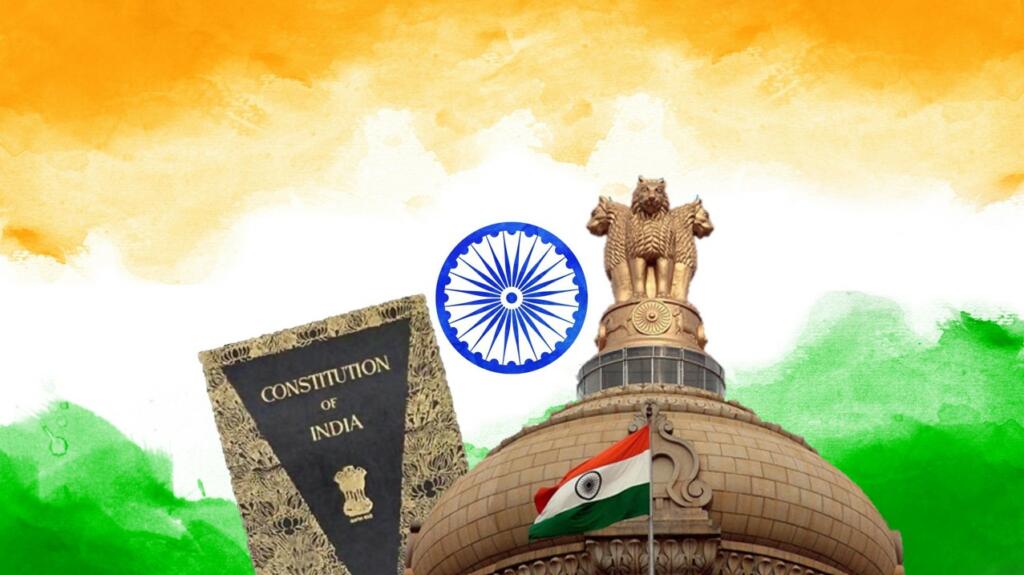The well-articulated Indian constitution is both flexible as well as rigid according to the needs of the day. However, the document which has prevented India’s Balkanisation is subject to certain criticisms. One of them is the assimilation of colonialism in a constitution meant to do away with the phenomenon.
So, we are back to our daily lives after a grand celebration of Republic Day. Many of us just do not realise how much significance does 26th January holds in our lives. It’s the day when the Indian constitution, the book guiding our polity came into effect. Republic day provides us with an opportunity to look at certain features of the document which our Prime Minister takes an oath by.
Indian Constitution is largely a borrowed one
Indian Constitution was not formed by people who sat there specifically for the purpose. Our Constitutional makers noted key features from other constitutions of the time and put them in different Articles.
When you watch our Prime Minister arranging his cabinet to make sure that Legislative procedures are adhered to in the Parliament, just remind yourself that all the above mechanisms involved in it are brought from British Constitution.
When you will watch a lawyer vociferously defending someone’s fundamental rights in Supreme Court, consider everything around you as a gift from US Constitution. Apart from the above, the process to remove Supreme Court and High Court judges has also been borrowed from the US. Even Impeachment of President is also a feature we took from US Constitution.
Similarly, Irish Constitution provided our elected representatives with a method to choose our President. Various other Key features have been taken from the Constitutions of South Africa, France, USSR, Germany, Australia, and Canada. Some experts call our Constitution a ‘patchwork’ of several documents of the world constitutions.
All these facts raise a question in our minds. If we have borrowed so much from others, what exactly is the guiding force of our Constitution?
Indian philosophy is not ingrained
Writing a constitution is not a daily life chore. When a nation sits down to formulate its guiding document, generally a mass uprising works as a guiding force in the background. For example, when French Constitution makers sat down to write theirs, they brought in Liberty, Fraternity and Equality from the French revolution.
US Constitutional makers noticed that their Governments (Britishers) were oppressors. So, they decided to protect future generations of individuals from such oppressors. The USA brought in a bill of rights to ensure an individual’s right supersedes over government except in certain circumstances.
Indian Constitution unfortunately did not derive any key philosophy from our independence movement. For our Constitutional makers, the Indian Constitution had to be the catalyst for a new revolution.
Talking about the process of Constitution formation, Jawahar Lal Nehru had remarked, “People seem to think of revolution as a big war, or a big internal struggle, violent struggle. Rather, revolution is something that changes the structure of the society, the lives of the people, the way they live and the way they work. That is what is happening in India.”
No one in the assembly mentioned that the fact that they were framing a constitution was because a revolution was working as a stable framework underneath.
A wide array of interpretative framework
When our leaders started to look for the drafters of the Constitution, most of those hunts zeroed down to lawyer-politicians. Lawyers’ minds are curious, and they tend to extend the argument as much as possible. In their minds, a particular word has more meaning than one. Thus, they tend to provide a wide array of interpretations.
Additionally, the legal system under which these lawyers were practising their trade was designed to tire the litigator. Britishers had designed it in such a way that it was next to impossible for a victim to get justice, simply because there were unnecessary paperwork and checks and balances.
Unfortunately, this is true for independent India as well. The wide diversion of philosophy in the Indian Constitution ensures that a particular case can be interpreted in varying fashions by different Courts. This adds to the burden of the judiciary. On the flip side, the lingering cases turn out to be a boon for lawyers who have multiple channels to earn from litigators.
H.K. Maheshwari, a member of the Constituent assembly had commented, “The draft tends to make people more litigious, more inclined to go to law courts, less truthful and less likely to follow the methods of truth and non-violence. If I may say so, the Draft is really a lawyers’ paradise. It opens up vast avenues of litigation and will give our able and ingenious lawyers plenty of work to do”.
Various other provisions like Minority Rights, protection of cows have been added in such a manner that the solution to the problem has led to complicating the original problem. In short, it can be said that Our Constitution makers framed Constitution for a problem that was thrust upon us by our Colonisers.
